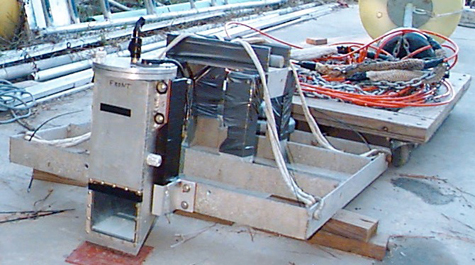VIMS professor to study effects of oil spill on Gulf food chain
Professor Bob Diaz of the Virginia Institute of Marine Science is part of a nationwide team that recently received a three-year, $12 million grant from the Gulf of Mexico Research Initiative to study the effects of the Deepwater Horizon oil spill on the Gulf and its marine life.
Diaz, an expert in low-oxygen dead zones and the ecology of bottom-dwelling marine communities, will use his $190,000 sub-contract to deploy two time-lapse seafloor cameras in a pair of shallow-water areas along the Louisiana shoreline—one inside and one outside the footprint of last summer’s spill.
{{youtube:medium:left|smkT9sR3fyY }}
These two “WormCams” will allow Diaz and VIMS marine technician Todd Nelson to monitor and compare the abundance and diversity of clams, worms, and other bottom-dwelling organisms at the oiled and un-oiled site. The oiled site is likely to be Terrebonne Bay, a marshy embayment along the southwestern side of the Mississippi Delta.
Diaz says it’s particularly important to monitor the spill’s long-term effect on shallow marshes and their “benthic” organisms because these bottom-dwelling communities form an important link in the marine food chain.
“Most of the oil that came ashore hit the shallow marshes along the Louisiana coast,” says Diaz. “These are key nursery areas for the area’s shrimp fisheries.” Louisiana landed 89 million pounds of shrimp in 2008—atop all Gulf states—with a dockside value of $130.6 million.
“WormCam will give us the ability to look at what’s known as sediment mixing or bioturbation,” says Diaz. “A big concern is that bottom-dwelling organisms may be ingesting the oil in the sediments and passing it up the food chain to shrimp and fishes. Hopefully we’ll be able to see if the organisms are avoiding the oiled sediment layers.”
Diaz will also use a sediment-profile camera to survey bottom-dwelling organisms on transects running perpendicular to shore—from just off the coast to the deeper waters at the edge of the continental shelf.
WormCam was developed at VIMS by Diaz and Nelson, using funds from a 3-year grant from the National Science Foundation to fellow VIMS professor Carl Friedrichs. The camera, which sits half-buried in seafloor sediments, takes time-lapse cross-sectional photographs that can clearly show the surprising abundance and diversity of life within what most regard simply as “mud.” The WormCam team field-tested and refined the camera during trials in the York River and Chesapeake Bay.
During the project in the Gulf of Mexico, Diaz and Nelson will attempt to send images from WormCam back to VIMS, where they plan to make them available via the VIMS website.
“We’ll be able to get some idea of abundance, recruitment, and development of animals,” says Diaz. “We’ll be able to see them as they come in, and as they grow. We’re likely to see some oil too—and to see if the organisms are avoiding the oily layers. That’s our ideal picture.”
“The idea is to run the cameras at selected times during all three years,” he adds. “I’m hoping we can get in all of the summers and some of the fall and spring.”
The grant to Diaz was part of a larger research partnership that is being led by the Louisiana Universities Marine Consortium, or LUMCON. Overall, the award involves 26 investigators from 12 institutions. In addition to VIMS and LUMCON, project partners hail from Louisiana State University, the LSU AgCenter, the University of Louisiana at Lafayette, Brigham Young University, Connecticut College, Florida Gulf Coast University, Woods Hole Oceanographic Institution, Rutgers-The State University of New Jersey, the University of Louisiana at Lafayette, the University of Maryland, and the University of Tennessee.
The overall project is in turn just 1 of 8 research projects announced on August 31 by the Gulf of Mexico Research Initiative as part of its Year 2 funding. GRI is a 10-year, $500 million independent research fund established by BP in the aftermath of the 2010 Deepwater Horizon Oil Spill. GRI projects are designed to study the impact of the oil spill and its associated response on the environment and on public health in the Gulf of Mexico. During Year 1 in 2010, five initial studies were commissioned to establish critical baseline data as the foundation for subsequent research.
















